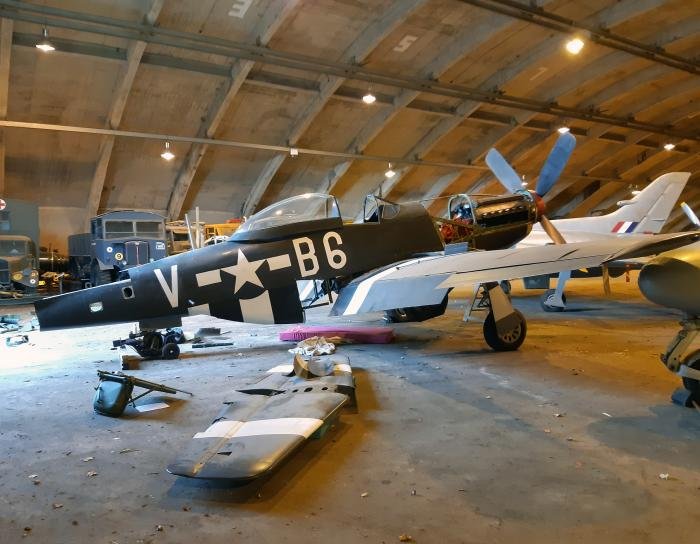P-51 gifted to Australian collection

North American P-51D Mustang 44-73415 left the RAF Museum Midlands at Cosford on 11 November, heading for a new home in New South Wales, having been gifted to the Scone airfield-based Hunter Fighter Collection as part of the RAFM’s current disposals and loans programme. The former US Army Air Forces/Royal Canadian Air Force fighter had been obtained by the RAFM in the late 1980s in a swap deal that saw Supermarine Spitfire XVI SL574, the former Bentley Priory gate guard, go to the USA. The Spitfire is now on show at the San Diego Air and Space Museum.
Airframes belonging to the Hunter Fighter Collection are displayed adjacent to the airworthy fleet of Hunter Warbirds, which already boasts a flying, former Royal Australian Air Force Commonwealth Aircraft Corporation-built Mustang, A68-107, at its aviation attraction.
Several museums and collections in the UK have expressed surprise at the RAFM’s decision to gift the Mustang to an organisation on the other side of the world, when it could have become a prized exhibit in a UK museum, especially at a time when heritage organisations in Britain are feeling the effects of the cost-of-living crisis and would welcome with open arms an uptick in visitor numbers that the addition of a World War Two fighter would bring.
In mid-November, Aeroplane sought to contact RAF Museum CEO Maggie Appleton about the story, but she was unavailable for comment. Adam Shepherd, head of collections services at the museum, did reply to a request from Aeroplane, saying, “Following the advertisement of the P-51D Mustang for transfer by gift, the RAF Museum received formal applications from UK and overseas organisations. Most of these applicants were not museums. RAFM’s cross-departmental assessment of these applications saw the Hunter Fighter Collection’s bid score the highest and indicated that they were in the best position to care for the aircraft long-term. The museum also deemed that the aircraft was more relevant to the access aims of this museum than the UK-based organisations”. However, this magazine has been informed that at least one major collection did apply for the Mustang, and it seems likely that others did too.
The Mustang was one of two owned by the RAFM. Florida-based former Jaguar racing driver and anglophile Bob Tullius donated his flyable P-51D, 44-74409, following the 2003 airshow season in the USA, and after being shipped to the UK it was unveiled during the opening of the Milestones of Flight building at Hendon on 17 December that year.
P-51D 44-73415 had been wrecked in a fatal accident following engine failure after take-off on 19 March 1977 at Olympia Municipal Airport, Washington and was subsequently restored by a now long-defunct California-based restoration company on behalf of the Eagle Squadron Association. Following its arrival at RAF Lyneham from the USA aboard an RAF Lockheed C-130K Hercules on 13 February 1989, the Mustang rebuild was found to be decidedly sub-standard, and a second restoration was entrusted to a largely volunteer team at the Halton-based No 1 School of Technical Training.
Work to bring the fighter up to museum display standard began with the total dismantling of the aircraft in June 1989, and over the next year tasks completed included the repair and correct fitting of engine cowlings, manufacturing and installation of engine carburettor air intake scoops and ducting, fitting of a radio aerial, skin repairs to the fuselage, provision of gun port leading edges, the correct fitting of all flying controls, provision of all hydraulic pipelines and components in undercarriage bays and a complete respray, the previous restoration having lacked even primer paint. The completed machine was unveiled at RAF Halton’s open day on 14 June 1990, and in March 1991 44-73415 went on display in the Bomber Command Hall at Hendon wearing the markings of a Mustang from the 357th Fighter Group, 363rd Fighter Squadron, based at Leiston, Suffolk during September 1944. It was moved to Cosford in July 2003, but has been kept in storage for the past few years.
Likewise gifted to the Hunter Fighter Collection by the RAFM is de Havilland Vampire FB5 WA346, which had also been in storage at Cosford. After it arrives at Scone in early 2023, the HFC will restore WA346 to represent one of Australia’s first jet fighters, FB5 A78-3, which was imported from Britain to familiarise the Royal Australian Air Force and Australian industry with the type prior to the manufacture of Vampires by de Havilland Australia, which built 88 examples at Bankstown.
Meanwhile, at Hendon in late November, Focke-Wulf Fw 190F-8/U1 Werknummer 584219 — the world’s only surviving two-seat example of the type, which was dismantled during the spring of 2022 — still hadn’t left for Germany, where it is said to be headed on loan to a major museum.

